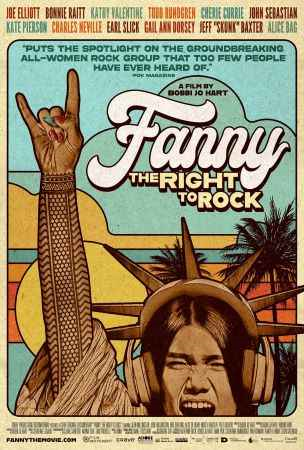
Fanny: The Right to Rock 2021
Distributed by Film Movement
Produced by Bobbi Jo Hart and Robbie Hart
Directed by Bobbi Jo Hart
Streaming, 96 mins
High School - General Adult
Rock Music; Women’s Rights
Date Entered: 08/11/2022
Reviewed by Linda Dempf, Music and Media Librarian, The College of New JerseyBobbi Jo Hart’s documentary tells the story of the forgotten all-female band Fanny, arguing that the band was a driving force in the late 1960s and early 70s, paving the way for women in rock. The narrative traces the band’s roots in Sacramento, where it began performing as The Svelts, eventually taking on the name Fanny. In 1969, the band moved to Los Angeles, living in what became known as the Fanny Hill House. They were part of the L.A. rock scene, performing in clubs, touring, and hosting regular jam sessions at the house with the likes of Bonnie Raitt, Bob Dylan, and members of Little Feat. Fanny cut several albums with major labels and toured in the U.S. and abroad through the mid-70s, often opening for other hard rock bands like Humble Pie and Deep Purple.
Fifty years after the bands’ founding, Fanny reunites to record a new album, “Fanny Walked the Earth” (2018), and the documentary interviews take place during this period, providing rich present-day reflections. These first-hand accounts from Fanny members are a powerful telling of the challenges experienced by women in rock, not only battling sexism, but racism and homophobia as well, as three of the band members were Filipina, and two were lesbians. The film effectively teases out the tension between the rebellion, outsider status, and artistic freedom that is characteristic of rock, and the control imposed by the record labels, agents, producers, and other star-maker machinery of popular music. One member acknowledged the “silent liberation” that music afforded, yet the band was up against a system that basically didn’t know what to do with them. Promoters encouraged Fanny to play up their image of having boyfriends, to wear skimpier outfits on stage, and managers retained a control on their finances and housing situation, creating tension, and leaving some band members artistically stifled.
In addition to the interviews with band members, we hear from a star-studded group of fellow rockers and producers, and several younger women talk about the impact that discovering Fanny has had on their musical lives. Fanny’s 1960s and 70s footage from concerts and recording sessions is compelling, and the soundtrack is terrific. The documentary would fill curricular needs in women’s and gender studies, music, and cultural studies.
Awards:Rogers Audience Choice Award, Hot Docs; Best Canadian Feature Film, InsideOut Toronto; Best Documentary, Outshine LGBTQ+ Film Festival; Best Music Documentary, Edmonton NW Film Festival; Audience Choice Award, San Diego Filipino Film Festival
Published and licensed under the Creative Commons Attribution 4.0 license. Anyone can use these reviews, so long as they comply with the terms of the license.